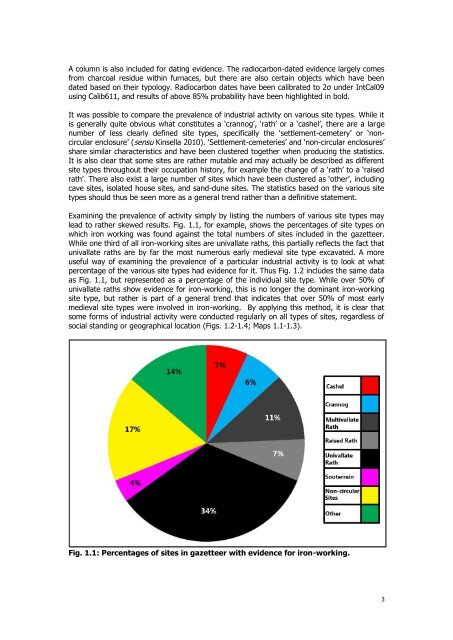EMAP_2012_Report_6_1.pdf (7.3 MB) - The Heritage Council
EMAP_2012_Report_6_1.pdf (7.3 MB) - The Heritage Council
EMAP_2012_Report_6_1.pdf (7.3 MB) - The Heritage Council
Create successful ePaper yourself
Turn your PDF publications into a flip-book with our unique Google optimized e-Paper software.
A column is also included for dating evidence. <strong>The</strong> radiocarbon-dated evidence largely comes<br />
from charcoal residue within furnaces, but there are also certain objects which have been<br />
dated based on their typology. Radiocarbon dates have been calibrated to 2σ under IntCal09<br />
using Calib611, and results of above 85% probability have been highlighted in bold.<br />
It was possible to compare the prevalence of industrial activity on various site types. While it<br />
is generally quite obvious what constitutes a ‘crannog’, ‘rath’ or a ‘cashel’, there are a large<br />
number of less clearly defined site types, specifically the ‘settlement-cemetery’ or ‘noncircular<br />
enclosure’ (sensu Kinsella 2010). ‘Settlement-cemeteries’ and ‘non-circular enclosures’<br />
share similar characteristics and have been clustered together when producing the statistics.<br />
It is also clear that some sites are rather mutable and may actually be described as different<br />
site types throughout their occupation history, for example the change of a ‘rath’ to a ‘raised<br />
rath’. <strong>The</strong>re also exist a large number of sites which have been clustered as ‘other’, including<br />
cave sites, isolated house sites, and sand-dune sites. <strong>The</strong> statistics based on the various site<br />
types should thus be seen more as a general trend rather than a definitive statement.<br />
Examining the prevalence of activity simply by listing the numbers of various site types may<br />
lead to rather skewed results. Fig. 1.1, for example, shows the percentages of site types on<br />
which iron working was found against the total numbers of sites included in the gazetteer.<br />
While one third of all iron-working sites are univallate raths, this partially reflects the fact that<br />
univallate raths are by far the most numerous early medieval site type excavated. A more<br />
useful way of examining the prevalence of a particular industrial activity is to look at what<br />
percentage of the various site types had evidence for it. Thus Fig. 1.2 includes the same data<br />
as Fig. 1.1, but represented as a percentage of the individual site type. While over 50% of<br />
univallate raths show evidence for iron-working, this is no longer the dominant iron-working<br />
site type, but rather is part of a general trend that indicates that over 50% of most early<br />
medieval site types were involved in iron-working. By applying this method, it is clear that<br />
some forms of industrial activity were conducted regularly on all types of sites, regardless of<br />
social standing or geographical location (Figs. 1.2-1.4; Maps 1.1-1.3).<br />
Fig. 1.1: Percentages of sites in gazetteer with evidence for iron-working.<br />
3
















